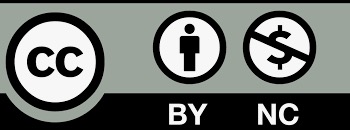Published
2025-03-17
Section
Research Articles
License
Copyright (c) 2025 Richard N. Verdeflor, Emma Q. Tenedero, Lanie M. Pacadaljen, Joy B. Araza, Abegail G. Bordios, Aeron P. Boller, Joseph B. Gonzales

This work is licensed under a Creative Commons Attribution-NonCommercial 4.0 International License.
The journal adopts the Attribution-NonCommercial 4.0 International (CC BY-NC 4.0), which means that anyone can reuse and redistribute the materials for non-commercial purposes as long as you follow the license terms and the original source is properly cited.
Author(s) shall retain the copyright of their work and grant the Journal/Publisher rights for the first publication with the work concurrently licensed since 2023 Vol.8 No.2.
Under this license, author(s) will allow third parties to download, reuse, reprint, modify, distribute and/or copy the content under the condition that the authors are given credit. No permission is required from the authors or the publisher.
This broad license intends to facilitate free access, as well as the unrestricted use of original works of all types. This ensures that the published work is freely and openly available in perpetuity.
By providing open access, the following benefits are brought about:
- Higher Visibility, Availability and Citations-free and unlimited accessibility of the publication over the internet without any restrictions increases citation of the article.
- Ease of search-publications are easily searchable in search engines and indexing databases.
- Rapid Publication – accepted papers are immediately published online.
- Available for free download immediately after publication at https://esp.as-pub.com/index.php/ESP

Copyright Statement
1.The authors certify that the submitted manuscripts are original works, do not infringe the rights of others, are free from academic misconduct and confidentiality issues, and that there are no disputes over the authorship scheme of the collaborative articles. In case of infringement, academic misconduct and confidentiality issues, as well as disputes over the authorship scheme, all responsibilities will be borne by the authors.
2. The author agrees to grant the Editorial Office of Environment and Social Psychology a licence to use the reproduction right, distribution right, information network dissemination right, performance right, translation right, and compilation right of the submitted manuscript, including the work as a whole, as well as the diagrams, tables, abstracts, and any other parts that can be extracted from the work and used in accordance with the characteristics of the journal. The Editorial Board of Environment and Social Psychology has the right to use and sub-licence the above mentioned works for wide dissemination in print, electronic and online versions, and, in accordance with the characteristics of the periodical, for the period of legal protection of the property right of the copyright in the work, and for the territorial scope of the work throughout the world.
3. The authors are entitled to the copyright of their works under the relevant laws of Singapore, provided that they do not exercise their rights in a manner prejudicial to the interests of the Journal.
About Licence
Environment and Social Psychology is an open access journal and all published work is available under the Creative Commons Licence, Authors shall retain copyright of their work and grant the journal/publisher the right of first publication, and their work shall be licensed under the Attribution-NonCommercial 4.0 International (CC BY-NC 4.0).
Under this licence, the author grants permission to third parties to download, reuse, reprint, modify, distribute and/or copy the content with attribution to the author. No permission from the author or publisher is required.
This broad licence is intended to facilitate free access to and unrestricted use of original works of all kinds. This ensures that published works remain free and accessible in perpetuity. Submitted manuscripts, once accepted, are immediately available to the public and permanently accessible free of charge on the journal’s official website (https://esp.as-pub.com/index.php/ESP). Allowing users to read, download, copy, print, search for or link to the full text of the article, or use it for other legal purposes. However, the use of the work must retain the author's signature, be limited to non-commercial purposes, and not be interpretative.
Click to download <Agreement on the Licence for the Use of Copyright on Environmental and Social Psychology>.
How to Cite
Changing mindsets of previously non-mathematics and science enthusiasts: Factors leading to shift of behaviors towards math and science
Richard N. Verdeflor
College of Education, Northwest Samar State University, Calbayog City, 6710, Philippines
Emma Q. Tenedero
College of Arts and Sciences, Samar State University, Catbalogan City, 6700, Philippines
Lanie M. Pacadaljen
Graduate School, Samar State University, Catbalogan City 6700, Philippines
Joy B. Araza
College of Arts and Sciences, Samar State University, Catbalogan City, 6700, Philippines
Abegail G. Bordios
College of Education, Samar State University, Catbalogan City, 6700, Philippines
Aeron P. Boller
Costa Rica National High School, Department of Education-Region 8, SDO-SAMAR 6724, Philippines
Joseph B. Gonzales
Parañaque National High School – Main, Department of Education-SDO Parañaque City, 1700, Philippines
DOI: https://doi.org/10.59429/esp.v10i3.3315
Keywords: growth mindset; learning anxiety; mindset shift; support
Abstract
Understanding the concept of mindset shift in education is essential as it offers important perspectives on how individuals’ beliefs and attitudes toward learning transform, affecting their motivation, involvement, and overall academic success. This study examined the experiences of college students who had previously experienced apprehension toward science and mathematics. The research aimed to understand the factors that influenced their attitudes toward these subjects and the mechanisms that facilitated a shift in their mindset. College students (n=16) were purposively sampled to participate in one-on-one interviews. Several factors contributed to these shifts, including teacher encouragement, the application of real-world concepts, and positive reinforcement. These elements helped shift students’ perceptions of these subjects, developing motivation for learning and engagement. The study also emphasized the importance of social interactions, guidance, and support from teachers and peers in facilitating mindset changes. As students transitioned from a fixed mindset to a growth mindset, they were more willing to embrace challenges, view mistakes as opportunities for learning, and persist in problem-solving tasks. This mindset shift helped them sustain their academic journey, as they became more open to deal with challenges, seek guidance when necessary, and persist through difficulties. Understanding how such shifts influence students’ resilience in the face of academic challenges could also contribute to the development of targeted interventions that enhance learning outcomes and build a lifelong love for learning.
References
[1]. 1.Zhao, F., Li, S., Li, T., & Yu, G. (2019). Does Stereotype Threat Deteriorate Academic Performance of High School Students With Learning Disabilities? The Buffering Role of Psychological Disengagement. Journal of Learning Disabilities, 52(4), 312-323. Doi: 10.1177/0022219419849107. Epub 2019 May 23. PMID: 31122139.
[2]. 2.Owens, J., & Massey, D. S. (2011). Stereotype Threat and College Academic Performance: A Latent Variables Approach. Social Science Research, 40(1), 150-166. Doi: 10.1016/j.ssresearch.2010.09.010. PMID: 23950616; PMCID: PMC3742025.
[3]. 3.Bofah, E. (2015). Reciprocal determinism between students’ maths self-concept and achievement in an African context.
[4]. 4.Schiavo, M., Prinari, B., Saito, I., Shoji, K., & Benight, C. (2018). A dynamical systems approach to triadic reciprocal determinism of social cognitive theory. Mathematics and Computers in Simulation, 159, 10.1016/j.matcom.2018.10.006.
[5]. 5.Liu, R., Jong, C., & Fan, M. (2024). Reciprocal relationship between self-efficacy and achievement in mathematics among high school students. Large-scale Assessments in Education, 12, 14. https://doi.org/10.1186/s40536-024-00201-2
[6]. 6.Kong Y. The Role of Experiential Learning on Students’ Motivation and Classroom Engagement. Front Psychol. 2021 Oct 22;12:771272. Doi: 10.3389/fpsyg.2021.771272. PMID: 34744950; PMCID: PMC8569223.
[7]. 7.Luu-Thi, H.-T., Ngo-Thi, T.-T., Nguyen-Thi, M.-T., Thao-Ly, T., Nguyen-Duong, B.-T., & Tran-Chi, V.-L. (2021). An Investigation of Mathematics Anxiety and Academic Coping Strategies Among High School Students in Vietnam: A Cross-Sectional Study. Frontiers in Education, 6, 742130. Doi: 10.3389/feduc.2021.742130
[8]. 8.Rozgonjuk, D., Kraav, T., Mikkor, K., Orav-Puurand, K., & Täht, K. (2020). Mathematics anxiety among STEM and social sciences students: the roles of mathematics self-efficacy, and deep and surface approach to learning. International Journal of STEM Education, 7, 46. https://doi.org/10.1186/s40594-020-00246-z
[9]. 9.Sumeera, & Khan, M., & Ilyas, M., & Abro, P., & Ahmed, N. (2024). Exploring the Factors of Anxiety Affecting Students’ Academic performance: A Study of Higher Education Institution of Larkana. Voyage Journal of Educational Studies, 4, 68-82. 10.58622/vjes.v4i1.117.
[10]. 10.Inoferio, H. V., Espartero, M. M., Asiri, M. S., et al. (2024). Coping with math anxiety and lack of confidence through AI-assisted learning. Environment and Social Psychology, 9(5), 2228. Doi: 10.54517/esp.v9i5.2228
[11]. 11.Zakaria, A., Budiarto, M. T., & Sulaiman, R. (2018). The Relational Thinking Process of Secondary School Student with High Mathematical Ability in Solving Mathematics Problem. Mathematics, Informatics, Science, and Education International Conference. Atlantis Press.
[12]. 12.Purbaningrum, M., Ramadhan, S., & Thauzahra, R. (2023). Why is Math Difficult? : Beliefs That Affecting Students’ Mathematics Skills. Jurnal Paedagogy, 10, 1000. 10.33394/jp.v10i4.8652.
[13]. 13.DES. (2017). STEM Education policy statement 2017–2026. Dublin: Department of Education and Skills.
[14]. 14.Kaur, T., McLoughlin, E., & Grimes, P. (2022). Mathematics and science across the transition from primary to secondary school: a systematic literature review. International Journal of STEM Education, 9, 13. https://doi.org/10.1186/s40594-022-00328-0
[15]. 15.Casad, B. J., & Merritt, S. M. (2014). The importance of stereotype threat mechanisms in workplace outcomes. Industrial and Organizational Psychology, 7, 413–419. Doi: 10.1111/iops.12170
[16]. 16.Casad, B. J., & Bryant, W. J. (2016). Addressing Stereotype Threat is Critical to Diversity and Inclusion in Organizational Psychology. Frontiers in Psychology, 7, 8. Doi: 10.3389/fpsyg.2016.00008
[17]. 17.Aronson, J., Burgess, D., Phelan, S. M., & Juarez, L. (2013). Unhealthy interactions: the role of stereotype threat in health disparities. American Journal of Public Health, 103(1), 50-6. Doi: 10.2105/AJPH.2012.300828. Epub 2012 Nov 15. PMID: 23153125; PMCID: PMC3518353.
[18]. 18.Pennington, C. R., Heim, D., Levy, A. R., & Larkin, D. T. (2016). Twenty Years of Stereotype Threat Research: A Review of Psychological Mediators. PLoS One, 11(1), e0146487. Doi: 10.1371/journal.pone.0146487. PMID: 26752551; PMCID: PMC4713435.
[19]. 19.Honicke, T., Broadbent, J., & Fuller-Tyszkiewicz, M. (2023). The self-efficacy and academic performance reciprocal relationship: the influence of task difficulty and baseline achievement on learner trajectory. Higher Education Research & Development, 42(8), 1936–1953. https://doi.org/10.1080/07294360.2023.2197194
[20]. 20.Chai, J., & Ye, J. H. (2024). A social network analysis of college students’ online learning during the epidemic era: A triadic reciprocal determinism perspective. Heliyon, 10(6), e28107. Doi: 10.1016/j.heliyon.2024.e28107. PMID: 38524571; PMCID: PMC10958418.
[21]. 21.Kamran, F., Kanwal, A., Afzal, D., & Rafiq, S. (2023). Impact of Interactive Teaching Methods on Students Learning Outcomes at University level. 7, 86-102.
[22]. 22.England, B. J., Brigati, J. R., Schussler, E. E., & Chen, M. M. (2019). Student Anxiety and Perception of Difficulty Impact Performance and Persistence in Introductory Biology Courses. CBE—Life Sciences Education, 18(2), ar21. Doi: 10.1187/cbe.17-12-0284. PMID: 31120397; PMCID: PMC6755222.
[23]. 23.Musa, N., & Maat, S. (2021). Mathematics Anxiety: A Case Study of Students’ Learning Experiences through Cognitive, Environment and Behaviour. International Journal of Academic Research in Business and Social Sciences, 11. 10.6007/IJARBSS/v11-i3/8992.
[24]. 24.Albastro, R., Albelar, D., Cajegas, A., Felicia, J., Leoncito, K., Libetario, C., Reyes, A., & Sitoy, M. (2023). Stress Levels: Factors, Challenges, and Coping Mechanisms in the Online Learning Modality among AdDU SHS Learners. 10.13140/RG.2.2.11495.21922.
[25]. 25.Craske, M. G., Treanor, M., Conway, C. C., Zbozinek, T., & Vervliet, B. (2014). Maximizing exposure therapy: an inhibitory learning approach. Behaviour Research and Therapy, 58, 10-23. Doi: 10.1016/j.brat.2014.04.006. Epub 2014 May 9. PMID: 24864005; PMCID: PMC4114726.
[26]. 26.Grillon, C. (2008). Models and mechanisms of anxiety: evidence from startle studies. Psychopharmacology, 199(3), 421–437. Doi: 10.1007/s00213-007-1019-1.
[27]. 27.Leon, A. J. T. D., Jumalon, R. L., Chavez, J. V., et al. (2024). Analysis on the implementation of inclusive classroom: Perception on compliances and obstructions of selected public-school teachers. Environment and Social Psychology, 9(9), 2537. Doi: 10.59429/esp.v9i9.2537
[28]. 28.Calaro, M. F., Vicente, M. B., Chavez, J. V., et al. (2023). Marketing campaigns leading to the purchase of Accommodation products: A content analysis. Journal of Namibian Studies: History Politics Culture, 33, 4221–4236
[29]. 29.Comeros, N. A., Cuilan, J. T., & Chavez, J. V. (2024). Parental Discretionary Influence on Their Children’s Manner of Learning English Language. Forum for Linguistic Studies, 6(4), 284-299. DOI: https://doi.org/10.30564/fls.v6i4.6656
[30]. 30.Nyimbili, F., & Nyimbili, L. (2024). Types of Purposive Sampling Techniques with Their Examples and Application in Qualitative Research Studies. British Journal of Multidisciplinary and Advanced Studies, 5, 90-99. 10.37745/bjmas.2022.0419.
[31]. 31.Campbell, S., Greenwood, M., Prior, S., Shearer, T., Walkem, K., Young, S., Bywaters, D., & Walker, K. (2020). Purposive sampling: complex or simple? Research case examples. Journal of Research in Nursing, 25(8), 652-661. Doi: 10.1177/1744987120927206. Epub 2020 Jun 18. PMID: 34394687; PMCID: PMC7932468.
[32]. 32.Beurskens, M., & Scherzinger, S. (2024). Legal Perspectives on Research Data Storage. Datenbank Spektrum, 24, 85–95. https://doi.org/10.1007/s13222-024-00478-1
[33]. 33.Braun, V., & Clarke, V. (2012). Thematic analysis. In: Cooper, H., Camic, P.M., Long, D.L., Panter, A.T., Rindskopf, D., Sher, K.J. (eds.) APA Handbook of Research Methods in Psychology, Research Designs, vol. 2, pp. 57–71. American Psychological Association, Washington.
[34]. 34.Byrne, D. (2022). A worked example of Braun and Clarke’s approach to reflexive thematic analysis. Qualitative Research in Psychology, 56, 1391–1412. https://doi.org/10.1007/s11135-021-01182-y
[35]. 35.Degorio, N. J. D., Diaz, P. A. N. E., Ando, C. V., Diquito, T. J. A., & Panerio, C. J. (2023). Exploring Science Learning Anxiety in the New Normal-An Exploratory Factor Analysis. American Journal of Human Psychology, 1(1), 39-49.
[36]. 36.Hanin, V., & Gay, P. (2023). Comparative analysis of students’ emotional and motivational profiles in mathematics in grades 1–6. Frontiers in Education, 8, 1117676. Frontiers Media SA.
[37]. 37.Kollosche, D. (2019). Reasons for auto-exclusion: Why students reject mathematics. Inclusive mathematics education: State-of-the-art research from Brazil and Germany, 449-465.
[38]. 38.Peiro-Signes, A., Trull, O., Segarra-Ona, M., & Garcia-Diaz, J. C. (2020). Attitudes towards statistics in secondary education: Findings from fsQCA. Mathematics, 8(5), 804.
[39]. 39.Geary, D. C., Hoard, M. K., Nugent, L., Ünal, Z. E., & Greene, N. R. (2023). Sex differences and similarities in relations between mathematics achievement, attitudes, and anxiety: A seventh-to-ninth grade longitudinal study. Journal of Educational Psychology, 115(5), 767.
[40]. 40.Vygotsky, L. S. (1978). Mind in society: The development of higher psychological processes. Harvard University Press.
[41]. 41.Laurillard, D. (2007). Modelling benefits-oriented costs for technology enhanced learning. Higher Education, 54, 21-39.
[42]. 42.Eremie, M. D., & Doueyi-Fiderikumo, J. (2019). Positive Reinforcement on Academic Achievement of Senior Secondary School Students in River State, International Journal of Innovative Development and Policy Studies, 7(1), 24-32.
[43]. 43.Molden, D. C., & Dweck, C. S. (2006). Finding" meaning" in psychology: a lay theories approach to self-regulation, social perception, and social development. American Psychologist, 61(3), 192.







